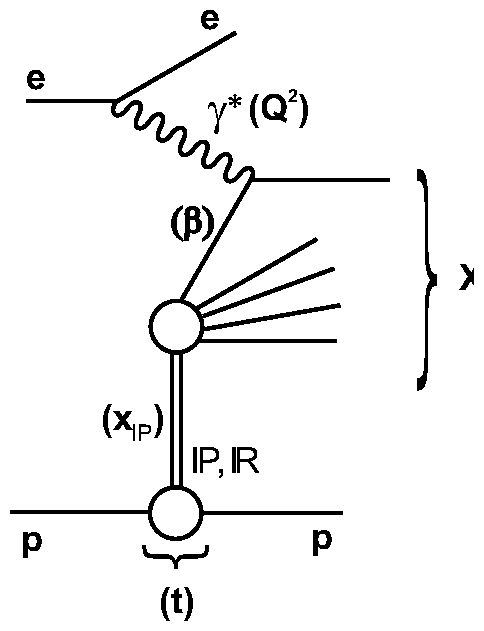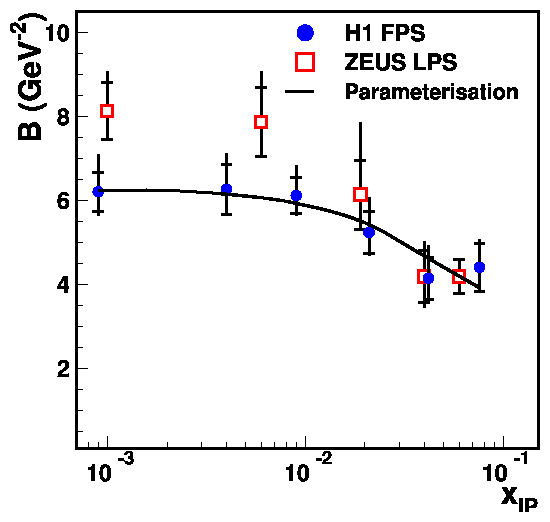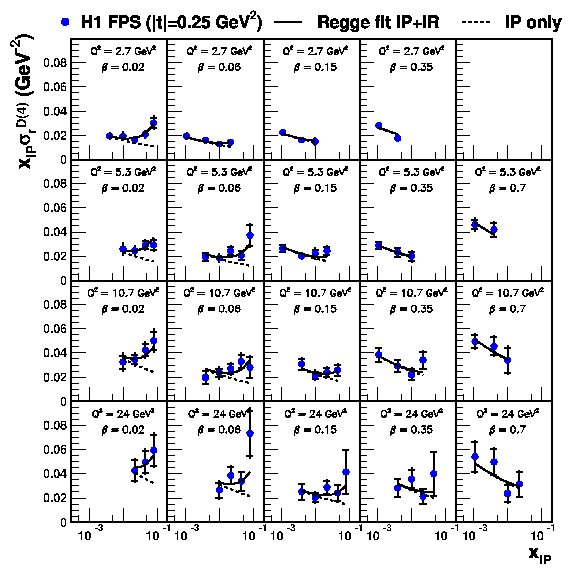 The
FPS data provide a means of studying inclusive diffraction as a
function of all relevant kinematic variables. In addition to t and
the usual DIS variables x and Q2, the
measurements are made as a function of the fractional proton
longitudinal momentum loss xIP and of
β=x/xIP,
which corresponds to the fraction of the exchanged momentum which
is carried by the quark coupling to the virtual photon. The
diffractive DIS data have been interpreted in a combined
framework, which applies the QCD factorization theorem to x
and Q2 dependences and uses a Regge
inspired approach to express the dependences on t and
xIP. The
dependences on xIP and t can then be
expressed in terms of an 'effective flux' of colorless exchange,
whilst the β and Q2 dependences can be
interpreted in terms of diffractive parton distribution functions
(DPDFs), which describe the partonic structure of that exchange.
Within Regge phenomenology, diffractive cross sections
are described by the exchange of a leading pomeron (IP)
trajectory αIP(t)=αIP(0)+α'IPt with an
intercept αIP(0)>1. In
order to describe the data at larger xIP, it is
necessary to include a sub-leading exchange trajectory (IR) with
an
intercept αIP(0)~0.5.
The
FPS data provide a means of studying inclusive diffraction as a
function of all relevant kinematic variables. In addition to t and
the usual DIS variables x and Q2, the
measurements are made as a function of the fractional proton
longitudinal momentum loss xIP and of
β=x/xIP,
which corresponds to the fraction of the exchanged momentum which
is carried by the quark coupling to the virtual photon. The
diffractive DIS data have been interpreted in a combined
framework, which applies the QCD factorization theorem to x
and Q2 dependences and uses a Regge
inspired approach to express the dependences on t and
xIP. The
dependences on xIP and t can then be
expressed in terms of an 'effective flux' of colorless exchange,
whilst the β and Q2 dependences can be
interpreted in terms of diffractive parton distribution functions
(DPDFs), which describe the partonic structure of that exchange.
Within Regge phenomenology, diffractive cross sections
are described by the exchange of a leading pomeron (IP)
trajectory αIP(t)=αIP(0)+α'IPt with an
intercept αIP(0)>1. In
order to describe the data at larger xIP, it is
necessary to include a sub-leading exchange trajectory (IR) with
an
intercept αIP(0)~0.5.
The t dependence of diffractive cross sections are commonly parameterized with an exponential, dσ/dt~eBt. The values of B resulting from such fits are shown as a function of xIP in the figure.
 Atlow xIP , the data are compatible
with a constant
slope parameter, B ≈ 6 GeV2. In a Regge approach
with a
single linear exchanged pomeron trajectory the slope parameter B
decreases with increasing xIP if α'IP>0
('shrinkage' of the
diffractive cone). The low xIP data thus favor a
small value of α'IP≈
0.06 GeV-2 ,
which is lower than α'IP≈
0.25 obtained from
soft hadronic interactions. Further analysis in which the slope B
is allowed to vary with β and Q2 shows no
significant dependences, confirming factorization of the
t dependence in the proton vertex for the present data.
Atlow xIP , the data are compatible
with a constant
slope parameter, B ≈ 6 GeV2. In a Regge approach
with a
single linear exchanged pomeron trajectory the slope parameter B
decreases with increasing xIP if α'IP>0
('shrinkage' of the
diffractive cone). The low xIP data thus favor a
small value of α'IP≈
0.06 GeV-2 ,
which is lower than α'IP≈
0.25 obtained from
soft hadronic interactions. Further analysis in which the slope B
is allowed to vary with β and Q2 shows no
significant dependences, confirming factorization of the
t dependence in the proton vertex for the present data.
The results of the FPS method are compared in detail with the measurement of diffractive processes selected on the basis of a large rapidity gap (LRG) in the distribution of the final state hadrons. The measured LRG process is ep→eXY where Y corresponds to proton dissociation state with mass MY<1.6 GeV. The ratio of the LRG to FPS cross sections is found to be independent on variables xIP, β and Q2 supporting factorization of the MY dependence in the proton vertex.
 In this paper diffractive reduced cross section σrD(4)(β,Q2,xIP,t)
is measured at |t|=0.25 GeV2. The xIP
dependence is described using a model which is
motivated by Regge phenomenology, in which a leading pomeron and a
sub-leading exchange contribute. The effective pomeron intercept
describing the data is αIP(0)~1.11,
which is consistent within the errors with the value αIP(0)~1.08
obtained from the energy dependence of
the total cross section. The data are also analyzed in terms of the
diffractive reduced cross section σrD(3)
obtained by integrating σrD(4)
over t. At fixed xIP,
a relatively flat β
dependence is observed over most of the kinematic range. The Q2
dependence displays positive scaling violations, except at
the highest β~0.7.
The β
and Q2 behavior of the reduced cross section
σrD(3)
is well described using DPDFs
extracted from a next-to-leading QCD fit to LRG
data.
In this paper diffractive reduced cross section σrD(4)(β,Q2,xIP,t)
is measured at |t|=0.25 GeV2. The xIP
dependence is described using a model which is
motivated by Regge phenomenology, in which a leading pomeron and a
sub-leading exchange contribute. The effective pomeron intercept
describing the data is αIP(0)~1.11,
which is consistent within the errors with the value αIP(0)~1.08
obtained from the energy dependence of
the total cross section. The data are also analyzed in terms of the
diffractive reduced cross section σrD(3)
obtained by integrating σrD(4)
over t. At fixed xIP,
a relatively flat β
dependence is observed over most of the kinematic range. The Q2
dependence displays positive scaling violations, except at
the highest β~0.7.
The β
and Q2 behavior of the reduced cross section
σrD(3)
is well described using DPDFs
extracted from a next-to-leading QCD fit to LRG
data.
In general, The FPS and
LRG data exhibit a remarkable consistency with 'proton vertex'
factorization, whereby the dependences on variables xIP ,
t and MY are completely independent of the
variables β and Q2
, which describe the hard interaction with the photon.